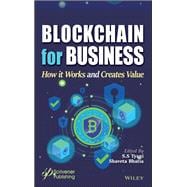The book focuses on the power of business blockchain. It gives an overview of blockchain in traditional business, marketing, accounting and business intelligence. The book provides a detailed working knowedge of blockchain, user cases of blockchain in business, cryptocurrency and Initial Coin Offering(ICO) along with the risks associated with them. The book also covers the detailed study of decentralization, mining, consensus, smart contracts, concepts and working of distributed ledgers and hyper ledgers as well as many other important concepts. It also details the security and privacy aspects of blockchain.
The book is beneficial for readers who are preparing for their business careers, those who are working with small scale businesses and startups, and helpful for business executives, managers, entrepreneurs, bankers, government officials and legal professionals who are looking to blockchain for secure financial transactions. The book will also be beneficial for researchers and students who want to study the latest developments of blockchain.









